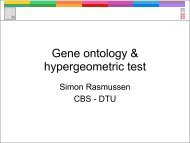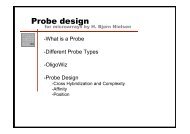Computational tools and Interoperability in Comparative ... - CBS
Computational tools and Interoperability in Comparative ... - CBS
Computational tools and Interoperability in Comparative ... - CBS
Create successful ePaper yourself
Turn your PDF publications into a flip-book with our unique Google optimized e-Paper software.
xviii<br />
2.17 Pan- <strong>and</strong> core-genome plot of 10 Campylobacter genomes. For the data<br />
currently available, there seem to exist an equilibrium at close to 600 prote<strong>in</strong><br />
families. . . . . . . . . . . . . . . . . . . . . . . . . . . . . . . . . . . . . . 24<br />
2.18 CorePlot output for 32 Vibrio genomes. . . . . . . . . . . . . . . . . . . . . 24<br />
3.1 The transcription of bacterial genes. . . . . . . . . . . . . . . . . . . . . . . 106<br />
3.2 The promotor structure of the rrnB operon <strong>in</strong> E. coli. . . . . . . . . . . . . 107<br />
3.3 The –10 <strong>and</strong> –35 hexamers of the E. coli σ 70 promotor correspond to the<br />
motifs be<strong>in</strong>g located on opposite side of the DNA helix. Delition or <strong>in</strong>sertions<br />
of the spac<strong>in</strong>g cases a shift of approx. 36deg per nucleotide. . . . . . 107<br />
3.4 Logo plots show<strong>in</strong>g the <strong>in</strong>itial weight matrices used for search<strong>in</strong>g E. coli<br />
<strong>and</strong> Shigella genomes: –10 hexamer (a), –35 hexamer (b), UP element (c),<br />
<strong>and</strong> FIS b<strong>in</strong>d<strong>in</strong>g motif (d). . . . . . . . . . . . . . . . . . . . . . . . . . . . . 109<br />
3.5 Neighbor-jo<strong>in</strong><strong>in</strong>g tree of first 1k bases of all 16S rRNA genes of Yers<strong>in</strong>ia,<br />
Salmonella, Shigella, <strong>and</strong> E. coli . . . . . . . . . . . . . . . . . . . . . . . . 110<br />
3.6 Profiles show<strong>in</strong>g the maximum Ri(tot) scores of the <strong>in</strong>itial weight matrices<br />
applied to E. coli <strong>and</strong> Shigella: Unadjusted P1 scores (a), Adjusted P1<br />
scores (b), Unadjusted P2 scores (c), <strong>and</strong> Adjusted P2 scores (d) . . . . . . 112<br />
3.7 Logos show<strong>in</strong>g the base compostion of P1 <strong>and</strong> P2 of E. coli genomes, as<br />
identified by <strong>in</strong>itial P1 <strong>and</strong> P2 scan: P1 –10 hexamer (a), P1 –35 hexamer<br />
(b), P1 UP element (c), P1 FIS b<strong>in</strong>d<strong>in</strong>g motif (d), P2 –10 hexamer (e), P2<br />
–35 hexamer (f), P2 UP element (g) . . . . . . . . . . . . . . . . . . . . . . 113<br />
3.8 Average profiles of SIDD energy calculated at five different helix densities<br />
-0.025, -0.035, -0.045, <strong>and</strong> -0.055. All genes have been aligned at the translation<br />
start. . . . . . . . . . . . . . . . . . . . . . . . . . . . . . . . . . . . 114<br />
3.9 E. coli <strong>and</strong> Shigella rrnB energy l<strong>and</strong>scape visualized us<strong>in</strong>g the heatmap<br />
function. Each vertical column corresponds to a promotor sequence, whereas<br />
the horizontal rows represent average values over 10 bp with<strong>in</strong> each sequence.<br />
Coord<strong>in</strong>ates labeled on the horizontal rows are relative to the 16S<br />
rRNA gene start. The upper heatmaps show P1 whereas the lower heatmaps<br />
show P2. Leftmost heatmaps show P1/P2 model scores <strong>in</strong> green, whereas<br />
rightmost heatmaps show the SIDD energy <strong>in</strong> blue. . . . . . . . . . . . . . 116<br />
3.10 Pr<strong>in</strong>ciple workflow of gwBrowser data exchange. . . . . . . . . . . . . . . . 118<br />
3.11 Mapp<strong>in</strong>g qualities of sequenc<strong>in</strong>g reads to a reference genome while account<strong>in</strong>g<br />
for the uniqueness of the read. . . . . . . . . . . . . . . . . . . . . . . . 118<br />
3.12 A zoom of the P1 P2 t<strong>and</strong>em promotor system upstream of the rrnB operon<br />
of E. coli K12. . . . . . . . . . . . . . . . . . . . . . . . . . . . . . . . . . . 119<br />
4.1 Screen shot of NCBI Entrez Genome projects web page . . . . . . . . . . . 146<br />
4.2 Schematic layout of a simple SOAP resource, where WSDL <strong>and</strong> schemas<br />
reside on the same server. WSDL <strong>and</strong> schemas are read <strong>and</strong> <strong>in</strong>tepreted<br />
by the SOAP client <strong>in</strong> order compose the outgo<strong>in</strong>g request <strong>and</strong> parse the<br />
<strong>in</strong>com<strong>in</strong>g server response. . . . . . . . . . . . . . . . . . . . . . . . . . . . . 149<br />
4.3 Schematic layout of the ENCODE pipel<strong>in</strong>e, EPipe. The ma<strong>in</strong> program<br />
ensures that as much as possible is dispatched <strong>in</strong> parrallel. Modules may<br />
either be alignment dependent or not. If the alignment is required to predict<br />
the prote<strong>in</strong> features, the module is not launched until the alignment<br />
algorithm has f<strong>in</strong>ished. Modules may either return global features of the<br />
entire prote<strong>in</strong> (e.g. cellular localization), or return positional features (e.g.<br />
phosphorylation sites). . . . . . . . . . . . . . . . . . . . . . . . . . . . . . 152









